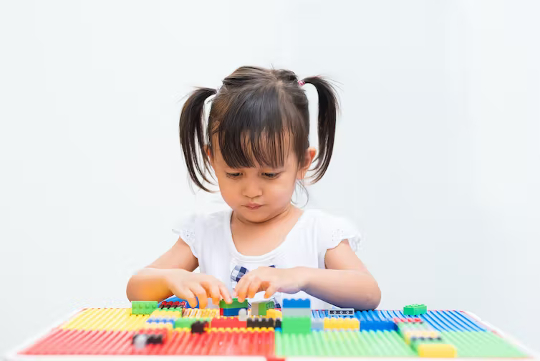Do you struggle to visualise how to rotate your shoes so that they nest together in a shoe box?
How are you with flat-packed furniture?
Are you good at giving directions?
These everyday activities require spatial thinking. Spatial thinking is important for mathematics, and it is what we use to understand the properties of objects, such as their location, size and shape, as well as the relationship between objects.
When we manipulate objects in our mind’s eye – such as visualising how to rearrange our living room – we are using spatial abilities. When we navigate our way home from a trip out, we are using spatial abilities.
People who have strong spatial skills are more likely to be interested in science, technology, engineering and maths (Stem) and to choose Stem degrees and Stem careers.
This association is unsurprising when you think about the skills required for Stem: using graphs to visualise patterns of data in maths, understanding the scale of a diagram of the solar system, or using the spatial layout of the periodic table to understand chemical relationships.
Nevertheless, spatial thinking is given little emphasis within the English national curriculum. It has recently been de-prioritised as an “early learning goal” for young children.
Lacking math skills
Prime Minister Rishi Sunak recently announced his ambition for all children to continue with maths education to age 18, citing the need for maths skills in the workforce. And it does seem that these skills are lacking.
The UK Stem industry is thought to lose £1.5 billion annually as a result of Stem skills shortages. Around half of working-age UK adults have only primary school level maths, and maths difficulties are estimated to cost the UK around £20.2 billion each year, according to the charity National Numeracy.
Sunak proposes to continue maths education past 16. But focusing on spatial training for younger children is one promising avenue for increasing maths enjoyment and maths achievement, as well as nudging the next generation towards Stem careers.
Spatial skills can be improved by training, and spatial training consistently increases achievement in mathematics and other Stem disciplines, including at degree level.
The largest effects of spatial training among children are for those from disadvantaged backgrounds. This means that spatial training provides an opportunity to reduce attainment gaps. It could bolster catch-up after pandemic school closures for the children most affected by this learning loss.
What’s more – and particularly important for maths’ sometimes dull image – spatial activities are enjoyable. Engagement scores for our spatial activities and training suggest that children like learning in this way.
Improving spatial ability
There are some easy ways to improve spatial ability. Visualisation – imagining a process in your head – has been linked to stronger science and maths performance and it can be improved through training.
Younger children could discover visualisation by being encouraged to imagine rotating jigsaw pieces in their head, rather than trying to fit pieces in a puzzle through trial and error. Older children could be prompted to use visualisation as a mental sketchpad when rearranging maths formulae.
Small-world play – such as with dolls houses or toy farm sets – can be used to help children learn to see things from other viewpoints and understand differences in spatial scale. Both of these are spatial skills which help with maths and science.
In a preprint study (which means it has not yet been reviewed by other scientists) colleagues and I have also found that following visual instructions when using construction toys, such as Lego, can help spatial skills.
It helps with mental rotation (rotating a piece in your mind to figure out which way round it should go) and understanding the relationship between parts and a whole, such as the individual bricks in a Lego model. This is useful for fractions and maths proficiency more generally.
As a final example, children who hear more spatial language have stronger spatial skills, and stronger spatial language is associated with better maths performance.
This means using words as simple as “in”, “on”, and “next to” to describe the spatial relationships between objects, or “small” and “big” to draw attention to the properties of objects. More difficult words like “parallel” and “separate” can help children to conceptualise otherwise difficult spatial concepts, particularly if hand movements are also used to help explain the meaning.
I am a member of the Early Childhood Maths Group, an independent group of early years mathematics enthusiasts and experts who work together to promote early childhood mathematics. The group has launched the Spatial Reasoning Toolkit to help adults support children’s development in spatial activities.
Introducing more spatial thinking to the curriculum could reduce attainment gaps, increase confidence and nudge children towards Stem careers. Children’s enjoyment of spatial activities could also help to change attitudes towards maths.![]()
About The Author
Emily Farran, Professor of Cognitive Development, University of Surrey
This article is republished from The Conversation under a Creative Commons license. Read the original article.

Related Books:
Here are 5 non-fiction books on parenting that are currently Best Sellers on Amazon.com:The Whole-Brain Child: 12 Revolutionary Strategies to Nurture Your Child's Developing Mind
by Daniel J. Siegel and Tina Payne Bryson
This book provides practical strategies for parents to help their children develop emotional intelligence, self-regulation, and resilience using insights from neuroscience.
Click for more info or to order
No-Drama Discipline: The Whole-Brain Way to Calm the Chaos and Nurture Your Child's Developing Mind
by Daniel J. Siegel and Tina Payne Bryson
The authors of The Whole-Brain Child offer guidance for parents to discipline their children in a way that promotes emotional regulation, problem-solving, and empathy.
Click for more info or to order
How to Talk So Kids Will Listen & Listen So Kids Will Talk
by Adele Faber and Elaine Mazlish
This classic book provides practical communication techniques for parents to connect with their children and foster cooperation and respect.
Click for more info or to order
The Montessori Toddler: A Parent's Guide to Raising a Curious and Responsible Human Being
by Simone Davies
This guide offers insights and strategies for parents to implement Montessori principles at home and foster their toddler's natural curiosity, independence, and love of learning.
Click for more info or to order
Peaceful Parent, Happy Kids: How to Stop Yelling and Start Connecting
by Dr. Laura Markham
This book offers practical guidance for parents to shift their mindset and communication style to foster connection, empathy, and cooperation with their children.






















